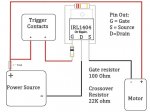I have a question I want to run by you all & get some opinions or suggestions. I am in the process of building a wooden box mod for myself, & was checking on some options. I'm doing the woodwork only, the wiring up will be done by a more qualified builder.
My question & confusion is in the area of switches, a mosfet vs. a 16-600 resettable fuse. I was told that the mosfet only protects the switch, & bypasses the current going through it, whereas the 16-600 protects the user. If too much current is going through the switch, the fuse trips & throttles down the current.
Maybe I am looking at this wrong, but I would think that protecting the user is paramount to anything else. I always use dual builds, w/ 26 or 24 gauge Kanthal, & I never go below .35 on my builds. Never. I'm just too nervous about super, sub low builds. So, could someone clue me in to which one is THE best one to use? I would be really grateful for any advice or suggestions.
My question & confusion is in the area of switches, a mosfet vs. a 16-600 resettable fuse. I was told that the mosfet only protects the switch, & bypasses the current going through it, whereas the 16-600 protects the user. If too much current is going through the switch, the fuse trips & throttles down the current.
Maybe I am looking at this wrong, but I would think that protecting the user is paramount to anything else. I always use dual builds, w/ 26 or 24 gauge Kanthal, & I never go below .35 on my builds. Never. I'm just too nervous about super, sub low builds. So, could someone clue me in to which one is THE best one to use? I would be really grateful for any advice or suggestions.

